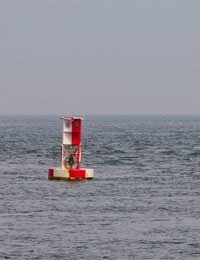Buoys and Marine Traffic Rules

Many boaters are attracted onto the water because of the freedom it offers away from the traffic clogged dry land, but in order to keep life on the water safe and free, there are nevertheless some ‘rules of the road’ that need to be observed.
Observing marine protocol includes understanding buoys, sound signals and the driving rules that apply when passing other vessels or travelling under the cover of darkness.
Buoys
Buoys are the road signs of the sea, directing water users along the safest course, around the threats of rocks, shoals and wrecks. There are four main buoy types – lateral markers, cardinals, ‘Dennis the Menace’ and safe water buoys.Lateral markers are sea buoys used in maritime navigation to indicate the edge of a designated roadway-like channel for vessels. When entering a harbour or river mouth, lateral buoy markers are used to map out a safe route through the water. Upon entry the red can-shaped port buoys should remain on a driver’s left-hand side, whilst the green starboard buoys should be on the right. Upon exit this rule is naturally reversed.
Cardinal buoys indicate areas of danger in the water and use the points of the compass to show safe passage. There are four types of Cardinal buoys, each using an arrow to represent a different point of the compass, and the direction of safe passage. If the buoy arrow points westward then the safe route is west and the danger is eastward.
‘Dennis the Menace’ buoys are so-named because of their red and black striped design, which is used to indicate isolated danger. Conversely the red and white striped safe water buoy is used to indicate that the surrounding water is safely navigable.
Rights of Passage and Sound Signals
The one key rule of the waterways that everybody should know is that when two boats meet head-on on the water the traditional method of avoiding collision is for both vessels to pass port to port by altering their course to starboard, the right of the driver.There are of course numerous instances where greater means of communication are required to broadcast driving intentions to other vessels. For such occasions boats are expected to use their horn signals. Although the vast majority of recreational boaters unable to communicate anything other than displeasure with their horn, it is standard practice for boat users to know the basic sound signals and be able to use them whenever there is a danger that needs broadcasting.
The correct ways of signalling with a horn on inland and coastal waters are as follows:
- One short blast – I am turning starboard side and will leave you to port side.
- Two short blasts – I am turning port side and will leave you to starboard side.
- Three short blasts – I am reversing my engines.
- One long blast – I am now getting underway.
- One long blast followed by one short blast – open the drawbridge please.
- Five short blasts – danger, please move out of the way. Or, don’t do what your signal indicates you are about to do.
If the recipient vessel has understood the sound blast message then they should repeat it to confirm. If they do not then they either did not hear correctly or do not understand horn signaling. If the response is five short blasts then this means the original intended action is dangerous.
Concessions for Small and Large Vessels
Concessionary measures and alternative rules apply to non-motorised craft such as sailboats or kayaks. The main practice is that such vessels have the right of way over powerboats because they might have a much harder time changing course abruptly. It is also good manners to motorised vessels to slow down when passing small yachts and rowboats to avoid upsetting them with a strong wake.When two sailboats come face to face with one another is standard practice for those on the port tack – those with the wind coming over the port side – to give way to sailboats on the starboard tack. If both vessels under sail have the wind on the same side then the sailboat to windward must give way to the one leeward.
At the other end of the scale are ships, which have the right of way over all other craft because of their slow manoeuvrability and the stringent course they must follow to avoid getting into difficulty.








